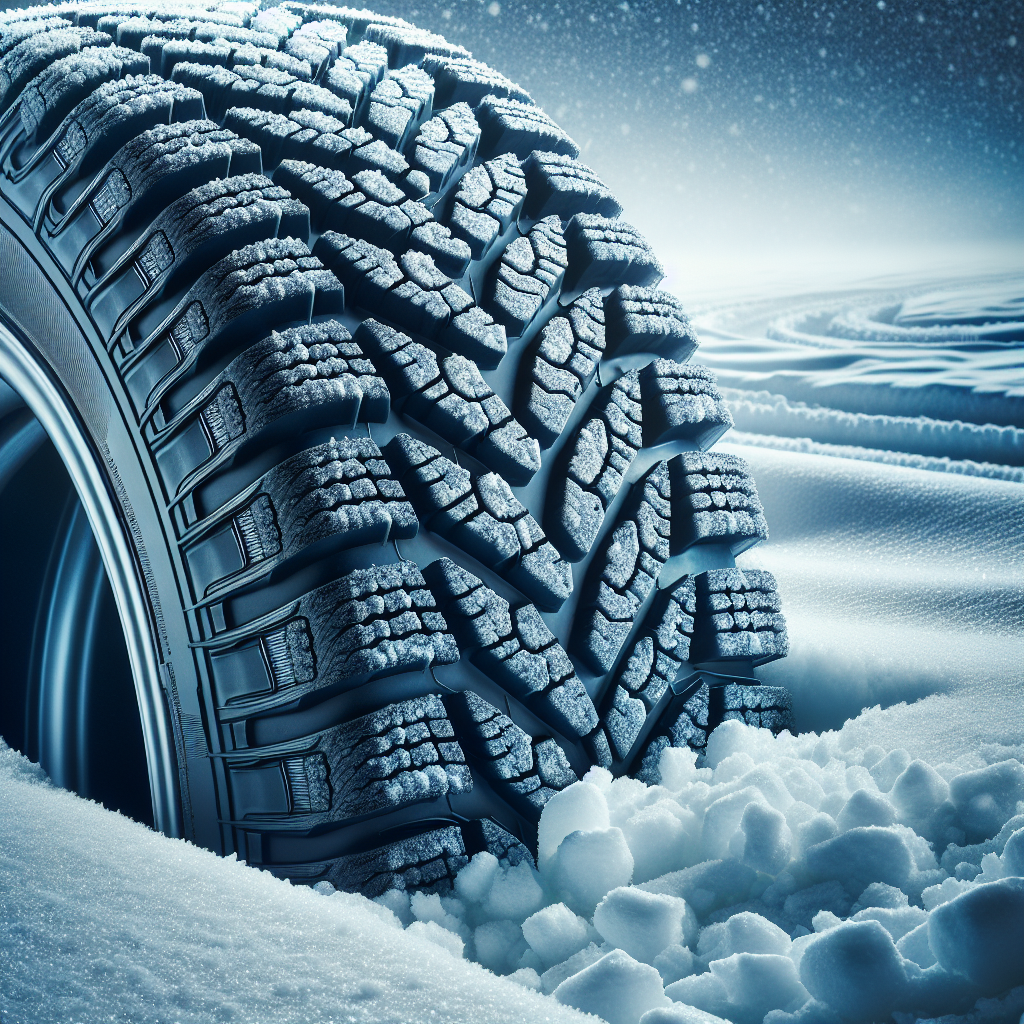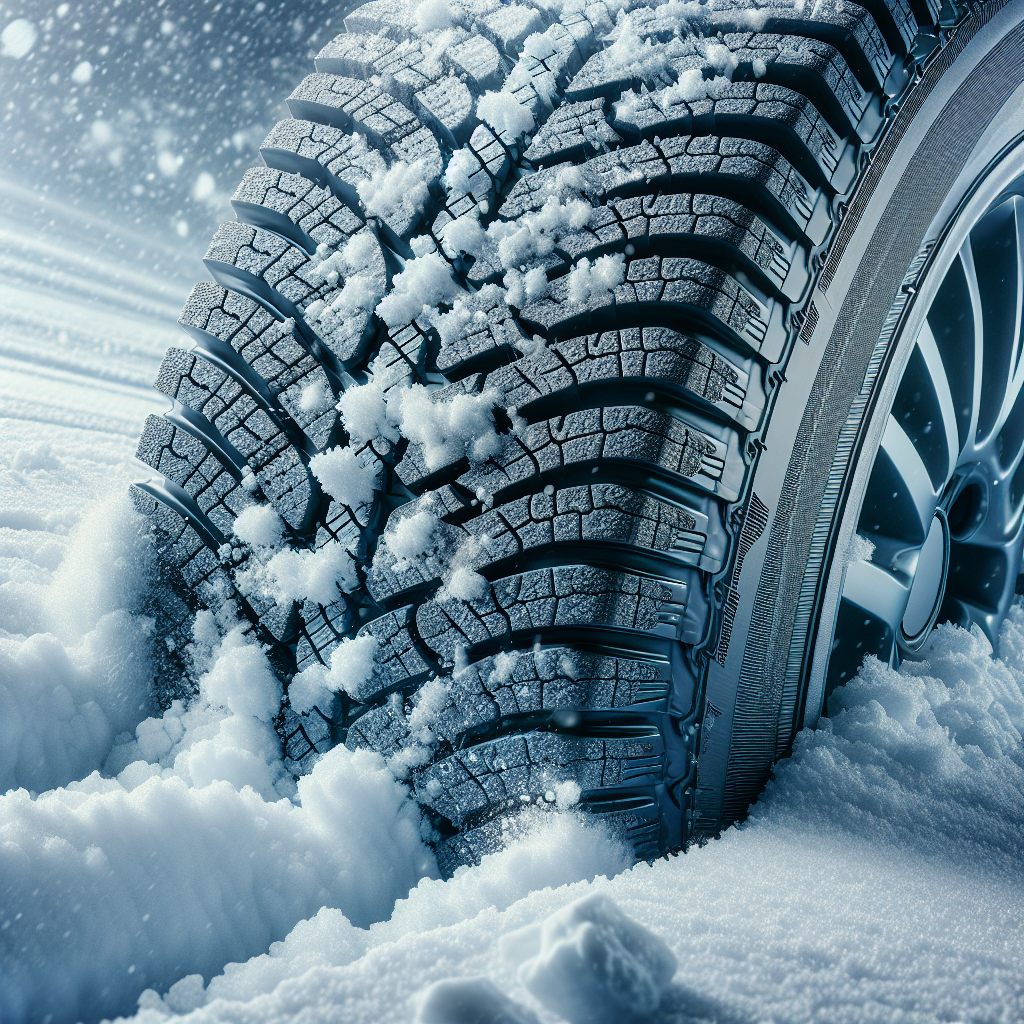Imagine driving through the snowy winter wonderland, feeling the crisp cold air against your face, and the soft crunch of snow beneath your tires. As you navigate the slippery roads, you might wonder how winter tires perform differently on compacted snow compared to loose snow. Well, wonder no more! In this article, we will explore the fascinating world of winter tire performance, comparing their effectiveness in both types of snow conditions. So, fasten your seatbelt and get ready to uncover the truth behind winter tires’ performance on compacted and loose snow!

Tire Tread Design
The Importance of Tire Tread
When it comes to winter driving, having the right tire tread design is crucial. The tread is the part of the tire that comes into direct contact with the road surface, and it plays a significant role in the tire’s performance. It is responsible for providing traction, grip, and handling, among other things. The tire tread design has a direct impact on how well a tire performs on different road conditions and terrains, including compacted snow and loose snow.
Different Tread Patterns for Winter Tires
Winter tires are specifically designed to enhance performance on snowy and icy roads. To achieve this, manufacturers use different tread patterns to maximize traction and grip. These tread patterns vary depending on the road conditions they are designed to tackle. Two common tread patterns for winter tires are the directional tread and the multi-directional tread.
The directional tread features deep, V-shaped grooves that are angled to channel snow, slush, and water away from the tire’s contact patch. This design enhances the tire’s ability to bite into the snow and maintain traction. On the other hand, the multi-directional tread, also known as the symmetric or non-directional tread, has zigzag patterns and sipes that provide multiple biting edges. This allows for better grip on both compacted and loose snow.
Traction and Grip
Tire Composition and Traction
In addition to tread design, tire composition also affects the traction and grip on compacted and loose snow. Winter tires are made from a unique rubber compound that remains flexible even in extremely low temperatures. This flexibility allows the tire to conform to the road surface, maximizing contact and grip. The rubber compound used in winter tires contains a higher percentage of natural rubber and specialized additives that enhance traction in cold conditions.
Grip on Compacted Snow
When driving on compacted snow, winter tires excel in providing exceptional grip. The tread patterns with deep grooves and sipes help the tires to bite into the snow, creating friction and preventing slippage. The specialized rubber compound maintains flexibility, ensuring the tires maintain contact with the road surface. This combination of tread design and rubber composition allows for enhanced traction on compacted snow, increasing overall safety and control while driving.
Grip on Loose Snow
Loose snow poses a different challenge for winter tires, as it is not as tightly packed as compacted snow. However, winter tires are still designed to perform well in these conditions. The multi-directional tread patterns, with their zigzag patterns and sipes, provide numerous biting edges. This allows the tires to dig into the loose snow, creating grip and preventing the tires from spinning out. The specialized rubber compound also plays a significant role in maintaining traction on loose snow by staying pliable and conforming to the contours of the road surface.
Handling and Steering Response
Stability on Compacted Snow
One of the key aspects of winter driving is maintaining stability, especially on compacted snow. Winter tires are designed to provide excellent stability by combining tread design, tire composition, and advanced engineering. The deep grooves on the tread, along with the sipes, help to evacuate water, slush, and snow from the contact patch. This prevents hydroplaning and improves stability by maintaining a consistent grip on the road. The flexible rubber compound ensures that the tire remains in contact with the road surface, allowing for precise steering response and control.
Maneuverability on Loose Snow
When it comes to maneuvering on loose snow, such as deep snowdrifts or freshly fallen snow, winter tires offer enhanced maneuverability. The multi-directional tread patterns with their zigzag patterns and sipes provide the necessary biting edges to cut through the loose snow and maintain control. This allows for confident steering and easier maneuvering, whether on slippery or uneven surfaces. Winter tires are designed to give drivers the ability to navigate through challenging conditions, making them an ideal choice for those living in areas with heavy snowfall.
Braking Performance
Stopping Distance on Compacted Snow
Braking performance is of utmost importance when driving on snow-covered roads. Winter tires are specifically designed to provide shorter stopping distances on compacted snow compared to all-season or summer tires. The deep grooves and sipes on the tread enhance grip, allowing for excellent braking power. The specialized rubber compound also plays a crucial role by maintaining flexibility, which ensures maximum contact with the road surface and minimizes the risk of skidding. The efficient braking performance of winter tires on compacted snow can significantly contribute to overall safety on wintry roads.
Stopping Distance on Loose Snow
In terms of stopping distances on loose snow, winter tires continue to excel. The multi-directional tread patterns with their zigzag patterns and sipes create more edges that bite into the loose snow, providing excellent stopping power. The flexible rubber compound further enhances braking performance by adapting to the road surface, allowing for responsive braking and minimizing the risk of sliding or losing control. Whether driving on compacted or loose snow, winter tires consistently deliver improved braking performance, providing drivers with peace of mind in challenging winter conditions.

Road Noise and Comfort
Noise Levels on Compacted Snow
Noise levels can be a concern when it comes to winter tires, especially on compacted snow. However, modern winter tires have made significant advancements in reducing road noise while maintaining excellent performance. The tread designs of winter tires aim to minimize noise by incorporating features that effectively disperse water, slush, and snow. By optimizing the tread patterns and tire composition, manufacturers can strike a balance between reducing noise levels and ensuring optimal performance on compacted snow. As a result, drivers can enjoy a comfortable and quiet ride even on snowy roads.
Comfort on Loose Snow
Comfort is another important factor to consider when driving on loose snow. Winter tires are designed to provide a smooth and comfortable ride, even in challenging winter conditions. The multi-directional tread patterns, along with the specialized rubber compound, contribute to a comfortable driving experience on loose snow. The tires’ ability to adapt to the road surface and maintain grip helps minimize vibrations and reduce the impact of uneven terrain, resulting in a more comfortable ride for both the driver and passengers.
Snow Accumulation and Slush Resistance
Tire Design Impact on Snow Accumulation
Winter tires play a significant role in preventing snow accumulation and maintaining traction on the road. The tread patterns, particularly those with deep grooves and sipes, effectively channel snow, slush, and water away from the contact patch. This prevents snow from packing in the tread and affecting the tire’s ability to maintain grip. Additionally, the tread patterns also play a role in breaking up snow and preventing it from compacting, further enhancing the tire’s performance on snowy roads. By minimizing snow accumulation, winter tires allow for better control and improved safety during winter driving.
Slush Clearance on Loose Snow
Driving through slush can be challenging, but winter tires are designed to handle such conditions effectively. The tread patterns on winter tires, especially those with deep grooves, are designed to disperse slush and water. This allows the tires to maintain contact with the road surface and prevent hydroplaning. The multi-directional tread patterns also contribute to slush clearance on loose snow by cutting through the slush and ensuring that the tires remain in contact with the road. Winter tires provide excellent resistance to slush buildup, enabling drivers to navigate through these conditions with confidence.

Wear and Durability
Tire Lifespan on Compacted Snow
The wear and durability of winter tires on compacted snow can vary depending on various factors such as driving habits, road conditions, and tire maintenance. However, winter tires are designed to withstand the harsh winter conditions and provide optimal performance throughout the winter season. The specialized rubber compound used in winter tires remains pliable even in low temperatures, minimizing wear and tear. The tread patterns with their deep grooves and sipes also contribute to longevity by effectively channeling water, snow, and slush away from the tire’s surface. With proper care and maintenance, winter tires can provide excellent durability and last multiple seasons.
Tire Lifespan on Loose Snow
Similar to their performance on compacted snow, winter tires exhibit good wear and durability on loose snow. The multi-directional tread patterns with sipes and deep grooves help to minimize wear by effectively dispersing snow and slush. The specialized rubber compound remains flexible, even in low temperatures, which reduces the risk of premature wear. Regular inspection, rotation, and maintenance of winter tires are essential for maximizing their lifespan on loose snow. By properly caring for winter tires, drivers can ensure long-lasting performance and ultimately, save money in the long run.
Temperature Range and Ice
Winter Tire Performance at Different Temperatures
Winter tires are designed to perform optimally in cold temperatures, making them suitable for winter driving. The specialized rubber compound used in these tires does not harden as much as that of all-season or summer tires, even in freezing temperatures. This allows the tires to maintain flexibility, essential for maximizing contact with the road surface. Winter tires continue to provide excellent traction, grip, and overall performance in a wide range of temperatures, ensuring drivers have the necessary control and confidence when driving on wintry roads.
Ice Traction on Compacted Snow
Ice traction is one of the most critical factors to consider when driving on compacted snow. Winter tires are designed to excel in providing traction on icy surfaces. The tread patterns, whether directional or multi-directional, combined with the specialized rubber compound, work together to deliver exceptional ice traction. The tread patterns cut through the thin layer of water on the ice, allowing the tires to make direct contact with the frozen surface. This biting action minimizes slippage and enhances grip, significantly improving overall safety and control when driving on icy roads.
Ice Traction on Loose Snow
Winter tires also perform admirably in terms of ice traction on loose snow. The multi-directional tread patterns, with their zigzag patterns and sipes, create more biting edges that engage with the ice beneath the loose snow. This significantly improves traction, allowing for confident driving even on icy surfaces. The specialized rubber compound maintains flexibility, ensuring that the tires conform to the contours of the road, maximizing contact and grip. Whether on compacted or loose snow, drivers can trust winter tires to provide excellent ice traction, enabling them to navigate icy roads with ease.

Overall Performance Comparison
Advantages of Winter Tires on Compacted Snow
Winter tires offer numerous advantages on compacted snow compared to all-season or summer tires. The deep grooves and sipes on the tread allow for enhanced traction, grip, and braking performance. The specialized rubber compound maintains flexibility in low temperatures, ensuring the tire remains pliable and in contact with the road surface. The tread design also plays a crucial role in preventing snow accumulation, enhancing stability, and providing a comfortable driving experience. Overall, winter tires excel in performance and safety on compacted snow, making them a worthy investment for winter driving.
Advantages of Winter Tires on Loose Snow
Winter tires also demonstrate significant advantages when it comes to driving on loose snow. The multi-directional tread patterns with their zigzag patterns and sipes provide excellent grip, maneuverability, and braking on loose snow. The specialized rubber compound remains flexible, allowing for optimal contact with the road surface and improved overall performance. Winter tires’ ability to handle loose snow with ease ensures drivers can confidently navigate through challenging winter conditions, making them a reliable choice for those living in areas with heavy snowfall.
Disadvantages of Winter Tires on Compacted Snow
While winter tires perform exceptionally well on compacted snow, they do have a few disadvantages. The deep grooves and sipes that enhance traction and grip on compacted snow can reduce performance on dry or wet pavement. The soft rubber compound used in winter tires may wear out faster on non-winter surfaces, leading to a shorter overall lifespan. Additionally, winter tires tend to generate more road noise than all-season or summer tires on non-snowy roads. It is essential to consider these factors when choosing winter tires specifically for compacted snow.
Disadvantages of Winter Tires on Loose Snow
Similarly, winter tires have a few disadvantages when it comes to loose snow. The multi-directional tread patterns that excel in providing grip and maneuverability on loose snow may not perform as well on dry or wet pavement. The specialized rubber compound, while essential for maintaining flexibility and grip on loose snow, may wear out more quickly when driven extensively on non-winter surfaces. Additionally, the deep grooves and sipes that help disperse snow and slush can also collect rocks or debris on non-snowy roads, leading to potential damage. As with any tire, it is important to consider these factors when choosing winter tires for loose snow.
Choosing the Right Winter Tires
Considerations for Compacted Snow
When choosing winter tires for compacted snow, several factors should be taken into account. The tread pattern and depth of grooves should be considered to ensure optimal traction and bite into the snow. A directional tread pattern with deep, V-shaped grooves tends to perform well on compacted snow. Additionally, the tire’s rubber compound should remain flexible in extremely low temperatures to maintain grip on compacted snow. It is also important to choose a tire size that is compatible with the vehicle’s specifications and to consult tire manufacturers’ recommendations for the best performance on compacted snow.
Considerations for Loose Snow
When selecting winter tires for loose snow, factors such as tread design and rubber compound are crucial. Tires with multi-directional tread patterns and zigzag patterns perform well on loose snow by providing excellent grip and maneuverability. The specialized rubber compound should remain flexible in low temperatures, allowing the tire to conform to the contours of the road and maximize contact. As with choosing tires for compacted snow, it is vital to consider tire size and consult tire manufacturers’ recommendations for optimal performance on loose snow.
In conclusion, winter tires are specifically designed to excel in performance and safety on snowy and icy roads. The tread patterns, tire composition, and advanced engineering combine to provide enhanced traction, grip, handling, and braking on both compacted and loose snow. While there may be some disadvantages associated with winter tires, their overall advantages make them a reliable choice for winter driving. When choosing winter tires, it is essential to consider factors such as tread design, rubber compound, and tire size based on the specific road conditions you will be facing. By selecting the right winter tires, you can ensure a smooth and safe driving experience throughout the winter season.


